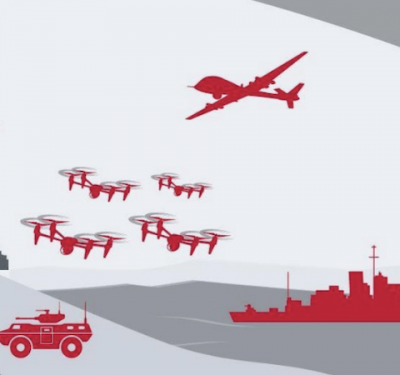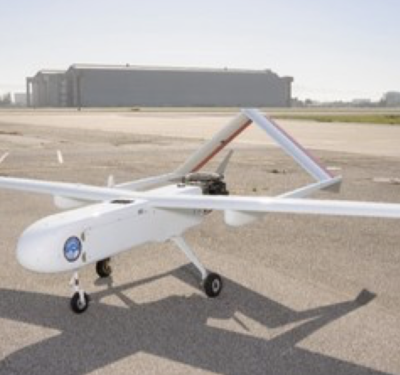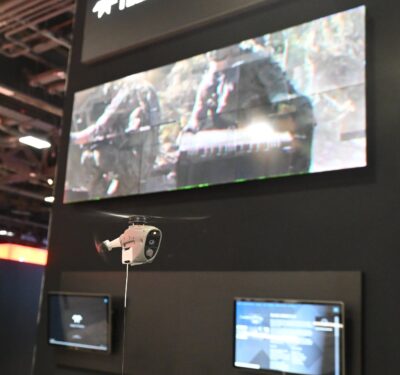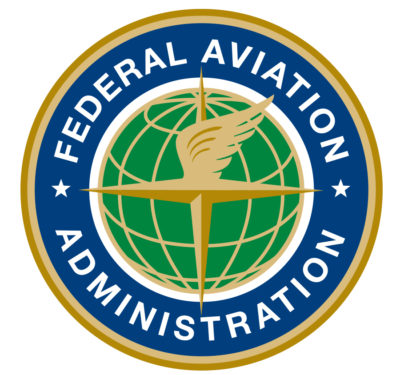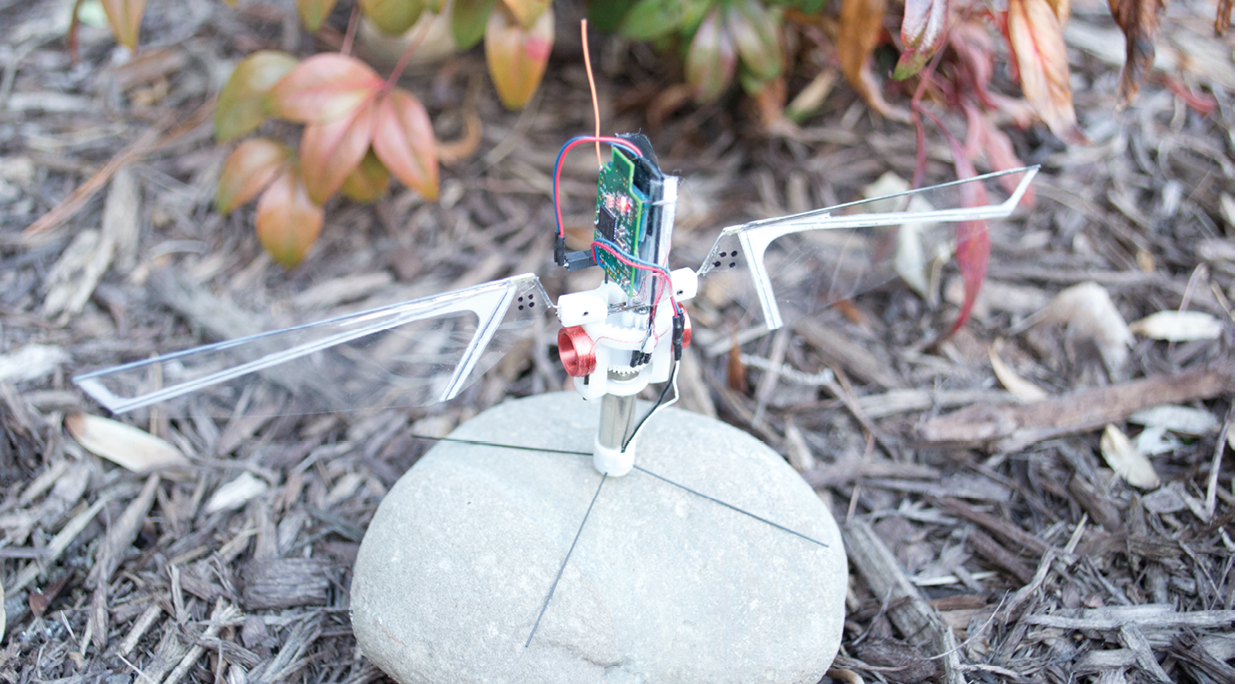
Courtesy Sean Humbert
If you’ve ever tried to kill a fly, you know how resilient they can be. Colliding with the window doesn’t seem to phase these insects, and they’ve all but mastered the art of avoiding obstacles during flight—a skill that Unmanned Aircraft Systems (UAS) also must master before they can be safely flown in the National Airspace.
About five years ago, Patrick Thévoz, co-founder and CEO of Flyability, began studying flies for this very reason. He wanted to create an unmanned aircraft that could run into obstacles and keep flying, making it safer and more useful for applications ranging from search and rescue missions to boiler inspections. One result of that research is the Gimball—a collision-tolerant drone that features a patented rotating protective cage. Rather than avoiding obstacles, it uses them during a flight to reach places that are too dangerous for humans and that other drones simply can’t get to.
“We put hundreds of flies in a plastic cage with highspeed cameras to look at how they were flying,” said Thévoz, who started Flyability about two years ago. “One of the most important take-home messages was the ability of insects to fly in complex spaces. Basically their eyes were like little optical flow machines. But at the same time, it’s their mechanical resilience that allows them to recover almost instantly from a collision. We wanted to mimic that capability in flying robots.”
And they have. The Gimball has inspected tanks for Chevron—a task that usually requires someone to crawl inside the tank with a flashlight and small camera—has inspected boilers in power plants for leaks and was used to explore narrow ice crevices in the Swiss Alps.
While the Gimball isn’t as small as a fly, it wouldn’t be able to carry the necessary sensors and cameras if it was, its ability to mimic the insect’s resiliency makes it easier and less risky to use. But the researchers at Flyability aren’t the only ones looking to insects for inspiration, and flies aren’t the only bugs that drone designers can learn from. Wasps, hawk moths and dragonflies are among the other insects researchers are studying in the hope of developing unmanned aircraft systems (UAS) with similar characteristics.
Perception Control
There are many applications that call for smaller UAS, from delivering packages for Amazon to finding people lost in dangerous places. The problem is, traditional sensors and key algorithms generally can’t be scaled down that far. Insects like fruit flies and hawk moths can help researchers solve some of these challenges, Professor J. Sean Humbert said.
Through his work at the University of Maryland and now the University of Colorado Boulder, Humbert has studied insect perception and their innate ability to understand even the most complex environments and then react to them—and how those abilities can be applied to UAS.
Humbert has mostly looked at the novel sensors and sensory architecture insects use for navigation and has found they are very good at taking very dense streams of information and then extracting just the basics of what they need to function, which is proximity and relative velocity.
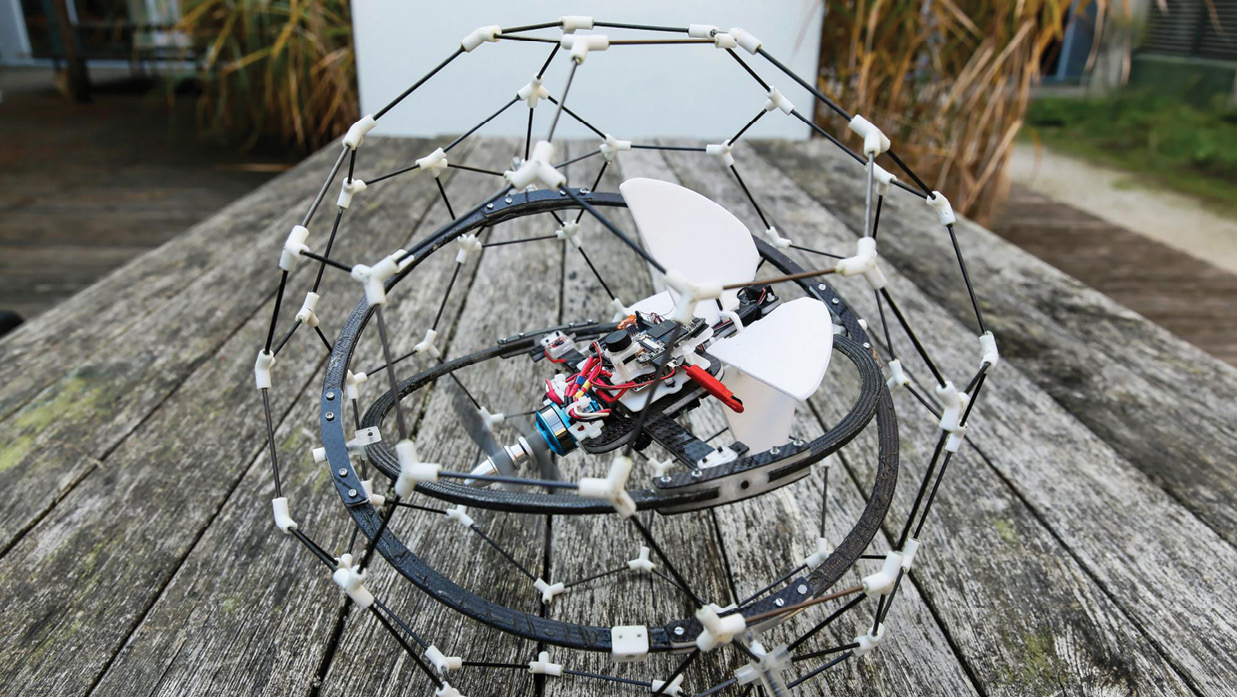
Courtesy Flyability
“We’ve developed sensors and feedback control algorithms to achieve cluttered-environment navigation based on that type of perception,” said Humbert, who worked with the Army for eight years to develop teams of insect-inspired robots for a variety of missions. “This process is much quicker and much simpler than a digital camera. Insects need to react quickly to things like clotheslines and powerlines, so their perception needs to be very fast. That’s where insects excel. They’ve optimized the temporal part of perception to minimize the time it takes to identify objects. Those are the abilities we’re trying to translate into the drones we’re building.”
Dario Floreano, a professor at the Swiss Federal Institute of Technology, also has studied insect perception control and how it can be applied to UAS—particularly UAS that need to fly in tight spaces. Like an insect, drones deployed to hazardous areas for search and rescue missions or to inspect a flare stack at a refinery need to see all around them as they fly.
The cameras traditionally found on UAS are similar to human eyes; they have one lens and see objects in high resolution, Floreano said. Insects, on the other hand, have hundreds of eyes that see the world in low resolution yet cover a large area. When an image moves across their eyes, they extract the information and capture mathematical relations, a fact Floreano said was only recently discovered.
“All insects on this planet use vision to maintain their altitude, to avoid collisions with obstacles, to find their nests and to do a lot of things,” Floreano said. “That’s how we started to develop a number of control algorithms that made their way to commercial drones.”
Miniaturizing UAS
About six years ago, TechJect won a contract from the U.S. Air Force to develop a miniature drone that could be used for a variety of complex applications, TechJect President Jayant Ratti said. The team set to work creating a UAS that mimicked the dragonfly.
The idea was to create a small UAS that was both covert and seemingly benign and that could fly for long endurance missions, Ratti said. The Robot Dragonfly is what they came up—it looks like a real dragonfly and is pocketable and disposable.
“Dragonflies in general are extremely efficient fliers,” Ratti said. “They have the ability to glide and the ability to hover. They can do both as a single entity. They can stop and go when they want, much like a helicopter, and can glide almost like an airplane.”
Small insects usually have wings with resonant mechanisms, that is the vibrations in one part of the system amplify those in another—a big energy saving principal, Ratti said. In the case of the Dragonfly, this insect has four wings, which gives it a lot of power and the ability to lift more. The Robot Dragonfly can carry a battery pack for power and is anywhere from six inches to 24 inches, depending on the wing size.
There are different versions of the Robot Dragonfly—one that’s proficient in forward flight that favors gliding and another that favors hovering, Ratti said. Those with smaller wing sizes are better at hovering and behave almost like a humming bird. The next version, coming out soon, will see a reduction in size to four inches.

And these insect-sized drones can be used for more than just military applications, Ratti said. He sees them offering benefits in security applications, infrastructure inspection and even pollen distribution.
“This is the next evolution up from regular flying drones,” Ratti said. “Especially when doing covert spy ops, small drones are the only thing that’s sustainable and insect-inspired drones give you the efficiencies you need. Butterflies can ride winds for days without stopping. Dragonflies fly for hours. As technology evolves, the goal is to get these drones small and the only way to get them small and efficiently fly them is through flapping wings. You can’t have propellers or regular airfoils. They have to flap.”
Swarming
In time, it will be common to see multiple UAS flying together in small spaces, which means they’re going to need to learn how to perceive each other and to coordinate their flight, Floreano said.
This is something insects do naturally. Honeybees swarm at very fast speeds. Mosquitos form a dense column and fly together in perfectly coordinated flights—without ever hitting each other. While not much is known about how they do this, Floreano said, studying these behaviors could help drones achieve something similar.
“Agencies will most likely only let drones fly over restricted areas, which will be like corridors where you have lots of drones flying at high speed like cars in the sky,” Floreano said. “How do we coordinate that? Drones could use the sounds of other drones to know where they are or they could use vision.”
The Challenges
While drones can learn a lot from insects, there are plenty of challenges to this type of research. For starters, insects are very small and it’s difficult to understand what neurons are involved in the computation and characterization of information, Humbert said. To help get past this, he works closely with biologists who understand insect physiology and anatomy to learn more about the functions of their different neural pathways.
“There are so many things we don’t know about how insects use vision to coordinate their flight,” Floreano said. “We have to work with biologists to study them and figure out what they use and translate that into algorithms that allow us to use a visual system for landing, take off, collision avoidance and flying with other drones.”
Miniaturization of the sensors and the actuation system is also difficult, Floreano said. It’s also key to finding the right materials that enable UAS to fly to have sufficient power to stay aloft for longer than 20 or 30 minutes.
This is pretty unconventional research, Ratti said, and there’s really no template to look at to help with the designs. Helicopters, for example, have evolved over many years and benefited from engineering improvements. Trying to mimic a complicated insect like the dragonfly, however, is comparable to developing a two or four stroke engine with multiple belts, drives and gears to get the right articulation of the wings so they flap effectively.
Like the Robot Dragonfly, Flyability’s Gimball has seen many different iterations, and Thévoz said one of the challenges was completing those iterations as quickly as possible. To make sure they were developing a product needed in the market, he and his team members spent, and still do spend, a lot of time in the field performing missions.
“It’s a very demanding field in terms of reliability and precision. You can’t just reboot your robot if it doesn’t work properly because it’s already broken by the time it needs a reboot,” he said. “And the market is very quickly developing. While the consumer drone market is pretty mature, it’s still being shaped. Business models are changing and the players are changing. You have to be able to adapt.”
The Future
As the technology evolves, UAS will continue to get smaller and more maneuverable, Floreano said. Drones that can move more like insects will be able to fly faster and more safely—a capability the Gimball has already achieved.
With the Gimball, operators don’t have to worry about making mistakes, Thévoz said. If the drone runs into something it won’t break or crash to the ground; its fly-inspired protective outer cage will enable it to keep flying to its destination. This also expands the type of applications it can perform. The cage separates the drone from the rest of the world, making it possible to bring it closer to people without worrying about injuries, as well as to deploy it inside buildings for a variety of dangerous inspections.
And the technology these researchers are working to develop isn’t just for small UAS, Humbert said. Mimicking how insects fly, whether you’re talking about a wasp, a moth or a fly, can benefit larger UAS as well.
“The main advantage of insects is they’re fast, lightweight and low power,” Humbert said. “That’s applicable to everything, even large commercial aircraft.”


